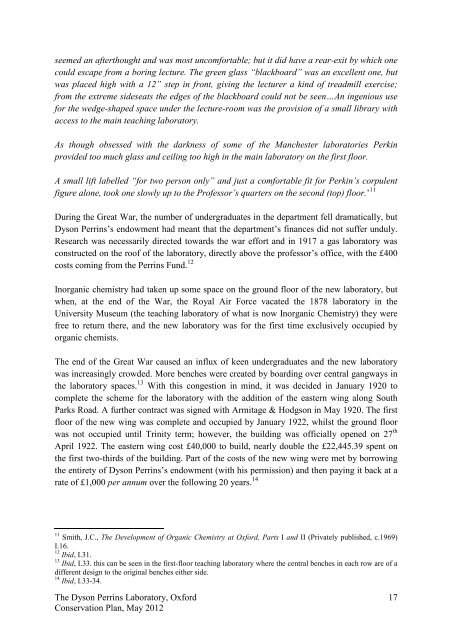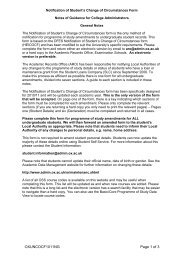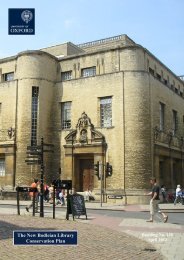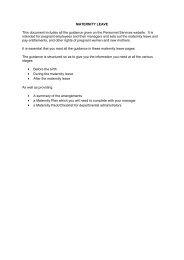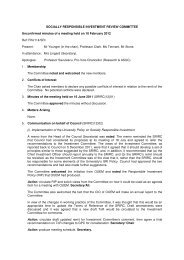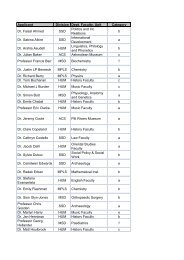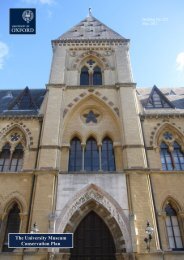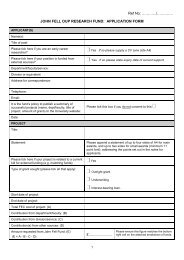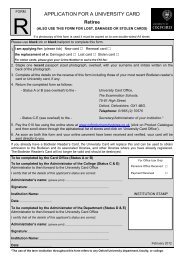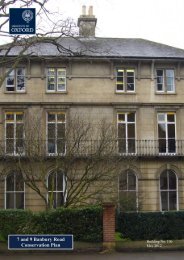the Great War in August, slowed construction considerably. Armitage & Lodge’s initialcontract had been to complete the building by 21 st April 1915; however, in May 1915 it wasreported that the building was at least 6 months from completion. 8As well as slowing down construction, the strikes and the outbreak <strong>of</strong> war had driven up costsconsiderably, and it became clear that the £20,000 available would only barely cover theconstruction <strong>of</strong> the building, and leave nothing for equipment or apparatus. The government,who had taken a great interest in the chemical research due to the ongoing war, wereapproached, but they indicated that they were more interested in funding specific projectsthan laboratories in general. 9 Warren again met with <strong>Dyson</strong> <strong>Perrins</strong> in May 1915. <strong>Dyson</strong><strong>Perrins</strong> famously remarked that this lunch at Magdalen was the most expensive he had evereaten, as it ultimately resulted in him providing (after some unsuccessful wrangling on hispart regarding the removal <strong>of</strong> compulsory Greek from the entry requirements for chemistry)the <strong>University</strong> with a further £25,000: £5,000 for the equipping <strong>of</strong> the laboratory, and a£20,000 endowment, which allowed it to remain independent <strong>of</strong> fees. <strong>Dyson</strong> <strong>Perrins</strong> met withPerkin for the first time a few weeks after he had <strong>of</strong>fered this £25,000 to Warren, and he wasevidently impressed with the Waynflete Pr<strong>of</strong>essor, insisting that the endowment should be forPerkin’s laboratory alone, ensuring that it was retained by the organic chemistry laboratory inperpetuity. 10Figure 3. Perkin in his researchlaboratoryThe <strong>University</strong> formally assigned the newlaboratory to the Waynflete Pr<strong>of</strong>essor inFebruary 1916, and the first stage <strong>of</strong> thebuilding (the central block and the westernwing; Figure 1) were complete and occupiedby Easter. The New Chemistry Department,as it was initially known, was <strong>of</strong>ficiallyopened with a reception hosted by Perkin andhis wife on 7 th June 1916. <strong>Dyson</strong> <strong>Perrins</strong>munificence was noted: In 1919 he wasawarded the honorary Doctorate <strong>of</strong> Civil Law;and in 1920 the New Chemistry Departmentwas formally renamed the <strong>Dyson</strong> <strong>Perrins</strong><strong>Laboratory</strong> at the urging <strong>of</strong> Warren.The new laboratory was a move towards bringing Oxford’s chemistry department in line withits potential, but as a building it was far from faultless:‘The red brick, the yellow stone, the big glass panes and the heavy ornamentation <strong>of</strong> thebuilding did not please everybody…<strong>Laboratory</strong> equipment was not lavish: there were novacuum or compressed-air lines, and not even steam for steam-baths…The lecture-room8 The iron drainpipes had been cast with an optimistic date <strong>of</strong> 1915 on them.9 Curtis et al., op. cit., 20.10 Ibid, 21.The <strong>Dyson</strong> <strong>Perrins</strong> <strong>Laboratory</strong>, Oxford 16Conservation Plan, May 2012
seemed an afterthought and was most uncomfortable; but it did have a rear-exit by which onecould escape from a boring lecture. The green glass “blackboard” was an excellent one, butwas placed high with a 12” step in front, giving the lecturer a kind <strong>of</strong> treadmill exercise;from the extreme sideseats the edges <strong>of</strong> the blackboard could not be seen…An ingenious usefor the wedge-shaped space under the lecture-room was the provision <strong>of</strong> a small library withaccess to the main teaching laboratory.As though obsessed with the darkness <strong>of</strong> some <strong>of</strong> the Manchester laboratories Perkinprovided too much glass and ceiling too high in the main laboratory on the first floor.A small lift labelled “for two person only” and just a comfortable fit for Perkin’s corpulentfigure alone, took one slowly up to the Pr<strong>of</strong>essor’s quarters on the second (top) floor.’ 11During the Great War, the number <strong>of</strong> undergraduates in the department fell dramatically, but<strong>Dyson</strong> <strong>Perrins</strong>’s endowment had meant that the department’s finances did not suffer unduly.Research was necessarily directed towards the war effort and in 1917 a gas laboratory wasconstructed on the ro<strong>of</strong> <strong>of</strong> the laboratory, directly above the pr<strong>of</strong>essor’s <strong>of</strong>fice, with the £400costs coming from the <strong>Perrins</strong> Fund. 12Inorganic chemistry had taken up some space on the ground floor <strong>of</strong> the new laboratory, butwhen, at the end <strong>of</strong> the War, the Royal Air Force vacated the 1878 laboratory in the<strong>University</strong> Museum (the teaching laboratory <strong>of</strong> what is now Inorganic Chemistry) they werefree to return there, and the new laboratory was for the first time exclusively occupied byorganic chemists.The end <strong>of</strong> the Great War caused an influx <strong>of</strong> keen undergraduates and the new laboratorywas increasingly crowded. More benches were created by boarding over central gangways inthe laboratory spaces. 13 With this congestion in mind, it was decided in January 1920 tocomplete the scheme for the laboratory with the addition <strong>of</strong> the eastern wing along SouthParks Road. A further contract was signed with Armitage & Hodgson in May 1920. The firstfloor <strong>of</strong> the new wing was complete and occupied by January 1922, whilst the ground floorwas not occupied until Trinity term; however, the building was <strong>of</strong>ficially opened on 27 thApril 1922. The eastern wing cost £40,000 to build, nearly double the £22,445.39 spent onthe first two-thirds <strong>of</strong> the building. Part <strong>of</strong> the costs <strong>of</strong> the new wing were met by borrowingthe entirety <strong>of</strong> <strong>Dyson</strong> <strong>Perrins</strong>’s endowment (with his permission) and then paying it back at arate <strong>of</strong> £1,000 per annum over the following 20 years. 1411 Smith, J.C., The Development <strong>of</strong> Organic Chemistry at Oxford, Parts I and II (Privately published, c.1969)I.16.12 Ibid, I.31.13 Ibid, I.33. this can be seen in the first-floor teaching laboratory where the central benches in each row are <strong>of</strong> adifferent design to the original benches either side.14 Ibid, I.33-34.The <strong>Dyson</strong> <strong>Perrins</strong> <strong>Laboratory</strong>, Oxford 17Conservation Plan, May 2012
- Page 1 and 2: Dyson Perrins LaboratoryBuilding No
- Page 3 and 4: THE RADCLIFFE CAMERA, OXFORDCONSERV
- Page 5 and 6: The Dyson Perrins Laboratory, Oxfor
- Page 8 and 9: The Conservation Plan should form t
- Page 10 and 11: TR.3, TR.11, TR.12 - Car Parking St
- Page 12 and 13: THIS PAGE HAS BEEN LEFT BLANKThe Dy
- Page 14 and 15: 2.2 History of the Dyson Perrins La
- Page 18 and 19: There were some issues with the new
- Page 20 and 21: Figure 5. Plan of Dyson Perrin’s
- Page 22: accommodate the changing needs of i
- Page 25 and 26: The Dyson Perrins Laboratory, Oxfor
- Page 27 and 28: 3 SIGNIFICANCENPPF paragraph 128 sp
- Page 29 and 30: something of a southern perimeter t
- Page 31 and 32: epresents a serious attempt to meet
- Page 33 and 34: The Dyson Perrins Laboratory, Oxfor
- Page 35 and 36: 4 VULNERABILITIESThe ability of the
- Page 37 and 38: viewed from the street.The landscap
- Page 39 and 40: The Dyson Perrins Laboratory, Oxfor
- Page 41 and 42: 5 CONSERVATION POLICYHaving establi
- Page 43 and 44: outine maintenance; others are impe
- Page 45 and 46: The Dyson Perrins Laboratory, Oxfor
- Page 47 and 48: 6 BIBLIOGRAPHY6.1 Government Report
- Page 49 and 50: Figure 7: Adapted from Bing Maps (s
- Page 51 and 52: The Dyson Perrins Laboratory, Oxfor
- Page 53 and 54: 7 APPENDICESAppendix 1Listed Buildi
- Page 55 and 56: INTERIOR: Main staircase in hall wi
- Page 57 and 58: Appendix 2Chronology of Dyson Perri
- Page 59 and 60: the road2004 Listed building consen
- Page 61 and 62: Appendix 3Checklist of Significant
- Page 63 and 64: Appendix 4Floor plansBasement plan
- Page 65 and 66: First-floor plan with north at the
- Page 67 and 68:
Third-floor plan with north at the
- Page 69 and 70:
The Dyson Perrins Laboratory, Oxfor
- Page 71 and 72:
8 ANNEXESAnnexe 1Development of the
- Page 73:
THIS PAGE HAS BEEN LEFT BLANKThe Dy


